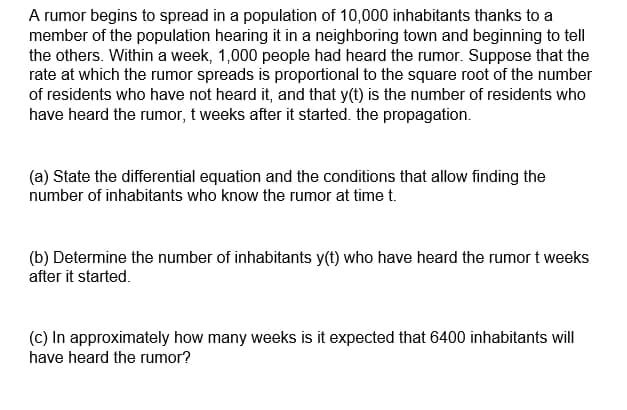A rumor begins to spread in a population of 10,000 inhabitants thanks to a member of the population hearing it in a neighboring town and beginning to tell the others. Within a week, 1,000 people had heard the rumor. Suppose that the rate at which the rumor spreads is proportional to the square root of the number of residents who have not heard it, and that y(t) is the number of residents who have heard the rumor, t weeks after it started. the propagation. (a) State the differential equation and the conditions that allow finding the number of inhabitants who know the rumor at time t. (b) Determine the number of inhabitants y(t) who have heard the rumor t weeks after it started. (c) In approximately how many weeks is it expected that 6400 inhabitants will have heard the rumor?
A rumor begins to spread in a population of 10,000 inhabitants thanks to a member of the population hearing it in a neighboring town and beginning to tell the others. Within a week, 1,000 people had heard the rumor. Suppose that the rate at which the rumor spreads is proportional to the square root of the number of residents who have not heard it, and that y(t) is the number of residents who have heard the rumor, t weeks after it started. the propagation. (a) State the differential equation and the conditions that allow finding the number of inhabitants who know the rumor at time t. (b) Determine the number of inhabitants y(t) who have heard the rumor t weeks after it started. (c) In approximately how many weeks is it expected that 6400 inhabitants will have heard the rumor?
Algebra & Trigonometry with Analytic Geometry
13th Edition
ISBN:9781133382119
Author:Swokowski
Publisher:Swokowski
Chapter7: Analytic Trigonometry
Section7.6: The Inverse Trigonometric Functions
Problem 94E
Related questions
Question

Transcribed Image Text:A rumor begins to spread in a population of 10,000 inhabitants thanks to a
member of the population hearing it in a neighboring town and beginning to tell
the others. Within a week, 1,000 people had heard the rumor. Suppose that the
rate at which the rumor spreads is proportional to the square root of the number
of residents who have not heard it, and that y(t) is the number of residents who
have heard the rumor, t weeks after it started. the propagation.
(a) State the differential equation and the conditions that allow finding the
number of inhabitants who know the rumor at time t.
(b) Determine the number of inhabitants y(t) who have heard the rumor t weeks
after it started.
(c) In approximately how many weeks is it expected that 6400 inhabitants will
have heard the rumor?
Expert Solution
This question has been solved!
Explore an expertly crafted, step-by-step solution for a thorough understanding of key concepts.
Step by step
Solved in 3 steps with 3 images

Recommended textbooks for you

Algebra & Trigonometry with Analytic Geometry
Algebra
ISBN:
9781133382119
Author:
Swokowski
Publisher:
Cengage

College Algebra
Algebra
ISBN:
9781305115545
Author:
James Stewart, Lothar Redlin, Saleem Watson
Publisher:
Cengage Learning

Trigonometry (MindTap Course List)
Trigonometry
ISBN:
9781337278461
Author:
Ron Larson
Publisher:
Cengage Learning

Algebra & Trigonometry with Analytic Geometry
Algebra
ISBN:
9781133382119
Author:
Swokowski
Publisher:
Cengage

College Algebra
Algebra
ISBN:
9781305115545
Author:
James Stewart, Lothar Redlin, Saleem Watson
Publisher:
Cengage Learning

Trigonometry (MindTap Course List)
Trigonometry
ISBN:
9781337278461
Author:
Ron Larson
Publisher:
Cengage Learning


Big Ideas Math A Bridge To Success Algebra 1: Stu…
Algebra
ISBN:
9781680331141
Author:
HOUGHTON MIFFLIN HARCOURT
Publisher:
Houghton Mifflin Harcourt

Algebra for College Students
Algebra
ISBN:
9781285195780
Author:
Jerome E. Kaufmann, Karen L. Schwitters
Publisher:
Cengage Learning